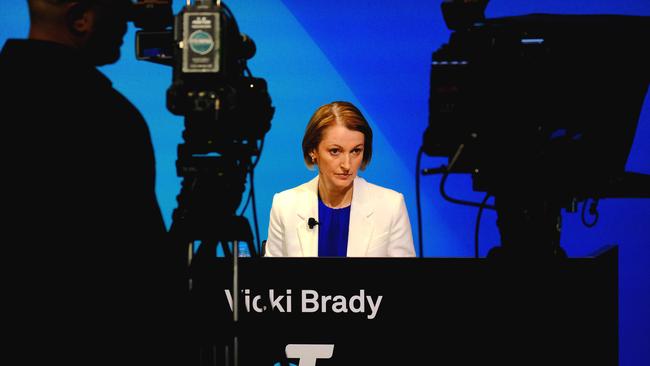Telstra taps AI, leaves door open for job cuts, in race to deliver $500m cost savings
Australia’s biggest telco has opened the door for potential job cuts as it aggressively shifts more tasks to artificial intelligence and races to deliver promised cost savings.
Business
Don't miss out on the headlines from Business. Followed categories will be added to My News.
Telstra has opened the door for potential job cuts as it aggressively shifts more tasks to artificial intelligence and races to deliver most of its promised $500m in savings by mid next year.
Australia’s biggest telco has achieved about $105m, or 20 per cent, of the savings outlined in its much-hyped T25 strategy. But chief executive Vicki Brady is adamant the company can deliver most of the remaining $400m in the next 18 months as it ramps up its cost cutting program.
Despite signing on 340,000 new customers in the six months to December 31, Ms Brady said Telstra only received a minor sugar hit from Optus’s catastrophic outage last November.
“In terms of the impact of the Optus outage … we’ve seen a net sign on impact we would estimate to be in the tens of thousands,” Ms Brady said.
Chief financial officer Michael Ackland said Telstra would take “more significant” action than it previously expected to deliver its T25 cost savings.
“We are committed to setting the business up for continued success and delivering on our growth strategy. We expect to achieve the large majority of our T25 $500m reduction ambition with most of this in FY 25.”
Ms Brady and Mr Ackland were speaking as Telstra delivered its half year earnings, which slightly missed analysts consensus estimates. They also lowered the top range of its full-year earnings guidance from $8.4bn to $8.3bn.
Despite hiking its interim dividend 5.9 per cent to 9c a share – representing a payout ratio of 107 per cent – Telstra shares fell 2.3 per cent to $3.90. This compared with a 0.8 per cent gain across the broader sharemarket.
Asked specifically if Telstra was considering laying off staff, Ms Brady did not rule it out.
She said the company was reviewing the cost base of Network and Services (NAS) business, which was “clearly a long way from where we need it to be” after it delivered flat revenue at $1.35bn.

“The work is underway right now in terms of what are the things we need to really get the cost base of our NAS business in the right shape,” Ms Brady said.
“I’m not at a stage of being able to announce exactly what those impacts look like and what they’ll mean. Obviously, as we work through these things, our first priority is making sure any costs that sit in that business that aren’t people-related, we’re absolutely optimising those.
“Then we will be obviously having to consider how do we deliver efficiently end-to-end for our customers in our NAS business and when we make those decisions – obviously – the first priority will be communicating any change to our team members internally.”
The T25 strategy follows Telstra’s T22 strategy, which involved $2.5bn in annual cost savings and a reduction of 8000 jobs over four years.
The telco is looking at a range of measures to deliver on its T25 savings including digitising IT operations and retiring legacy systems. Ms Brady said the company would increasingly use artificial intelligence, which has now been deployed across half of Telstra’s operations.
“Our ambition is to become an AI-fuelled organisation to help us unlock better outcomes for our customers, our people and organisation. To underpin this, we are simplifying and modernising our tech and data landscape and building reusable AI products for the whole organisation to accelerate time to value.
“We are now using AI to improve half of our key processes, including to automatically detect and resolve fixed services faults and to solve customer issues faster. For example, in the half (year), we piloted new AI applications including ‘Ask Telstra’ – an open AI-based solution with Microsoft to help our frontline teams find the information they need for better and more quickly serving our customers.”
Ms Brady said Telstra had also created an AI academy to train staff to use the technology.
Overall, Telstra’s half-year net profit rose 11.4 per cent to $964m. Revenue, meanwhile, firmed 1.1 per cent to $11.43bn.
Earnings before interest, tax, depreciation and amortisation rose 3.8 per cent to $4.01bn – compared with analyst consensus estimates of $4.04bn.
Milford investment manager Roland Houghton said the “disappointment in Telstra’s result stemmed from their enterprise division, specifically NAS”.
“Some of the slow down is cyclical as customers defer decisions however this division is under structural pressure – we’d expect them to right size the cost base whilst conditions remain challenging,” he said.
“The focus will now turn to FY25 dividends and whether the 19 cents expected is still possible. Should mobile market conditions remain rational and InfraCo earnings continue to grow this should be very achievable.”
Jarden analyst Tom Beadle said while the lowering of the EBITDA range may disappoint, “the weakness in NAS and 1H miss means the market could be underestimating the momentum in Telstra’s key mobile and InfraCo fixed businesses”.
“The decision to lift the dividend appears to show confidence that momentum in these businesses can continue.”
Telstra will pay its interim dividend of 9c a share, fully franked, on March 28. Despite the payout ratio being 107 per cent, Ms Brady said it was “consistent with Telstra’s capital management framework”.
“The important thing is as the board made its decision on the 9c dividend we have a very strong balance sheet, we have strong free cash flow able to support that dividend and under our capital management framework we have a policy to maximise our fully franked dividend and seek to grow it over time.”
Originally published as Telstra taps AI, leaves door open for job cuts, in race to deliver $500m cost savings





